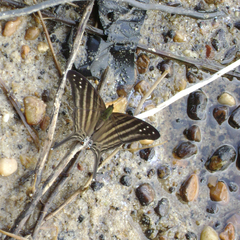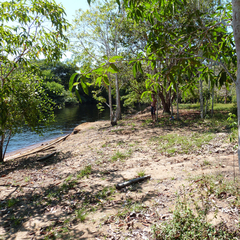Marpesia chiron (Fabricius, 1775)
Many-banded Daggerwing
Papilio chiron (Fabricius, 1775)
The Marpesia genus has about 20 species recorded in the Neotropics (Lamas, 2004). Some species are common on the banks of rivers, where they spend a lot of time sucking the moist soil. Females are rarely observed and caterpillars have spines on the back and in the head (Marigo & Otero, 1992).
Marpesia chiron make an aggregate of butterflies to sleep under a leaf, and disperse disperse when the daylight comes. Are migratory butterflies (Brown Jr. 1992)
Argentina; Ayiti; Brasil; Costa Rica; Cuba; El Salvador; Jamaica; México; Paraguay; Suriname; Uruguay; Venezuela
Female feed on nectar and male feed on wet sand
In Brazil are recorded as hos-plant, according Beccaloni et al. (2008):
Moraceae: Artocarpus sp., Artocarpus integrifolia, Ficus sp., Ficus pumila, Maclura pomifera, Morus alba, Morus nigra.
Rutaceae: Zanthoxylum rhoifolium
brown, cream
anthropogenic, open, forest edge, river bank
- Lamas G. (2004):
- Atlas of neotropical Lepidoptera - Checklist: Part 4A Hesperioidea - Papilionoidea. Book.: 1-439
- Beccaloni G.W, Viloria A.L., Hall S.K., Robinson G.S. (2008):
- Catalogue of the hostplants of the Neotropical butterflies. Book., London, S.E.A., Ribes, CYTED, Natural History Museum, IVIC: 1-536
- Otero L.S., Marigo L.C. (1992):
- Butterflies of Carajás. Book., Rio de Janeiro, Companhia Vale do Rio Doce: 1-76
- Brown Jr. K (1992):
- Borboletas da Serra do Japi: diversidade, habitats, recursos alimentares e variação temporal. In:n História Natural da Serra do Japi: ecologia e preservação de uma área florestal no Sudeste do Brasil., Campinas, Unicamp: 142-186





